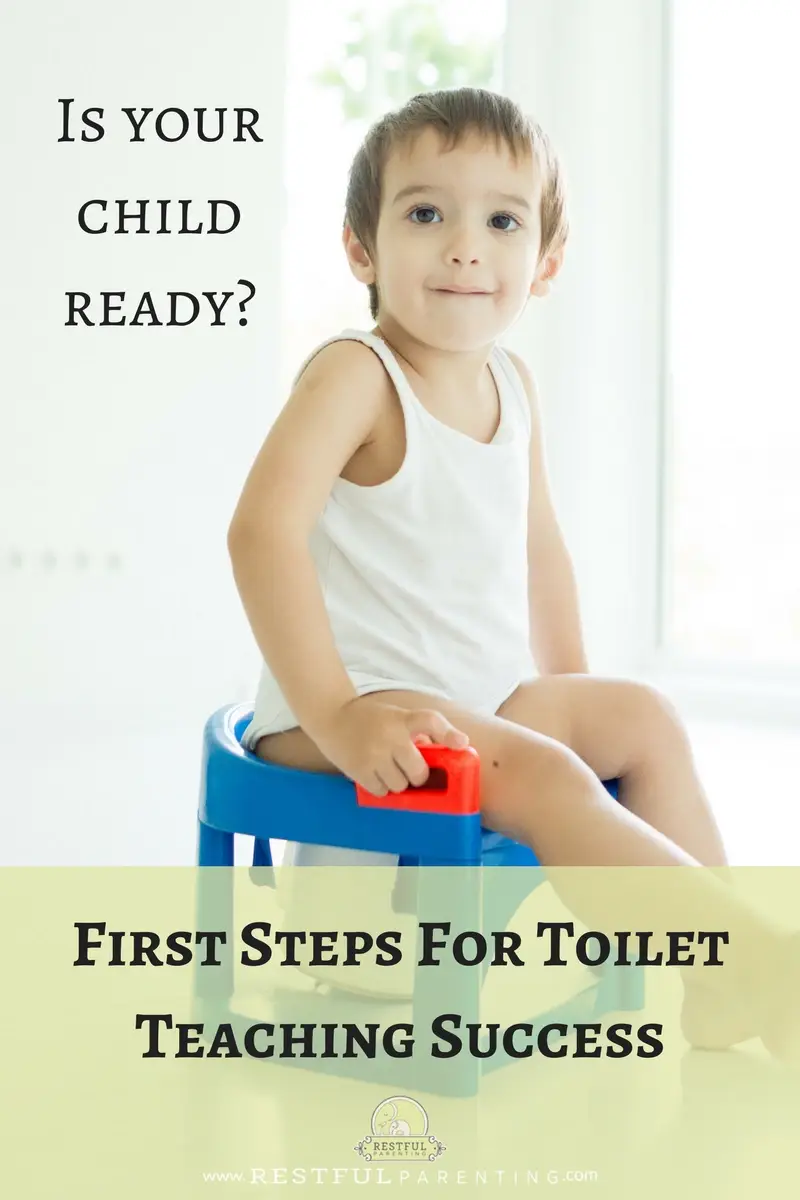As a new parent, these last few years have been full of milestones, giggles, temper tantrums and child rearing and now your next big step is toilet teaching!! Do those words give you a mini panic attack? Do you feel intimidated or overwhelmed with where to begin? Or, are you feeling excited for the challenge ahead?
With our backgrounds in Early Childhood Education and working in the childcare field for more years than we can count, we have ‘toilet trained’ dozens of little one’s successfully. One thing that we can tell you for sure is that as long as the child is ready, it can be a great experience! In fact, it can be quite stress free and positive when you let your child lead. The hardest part is when you are ready to be done with diapers but your child may not be there yet.
How do you know when your child is ready?
Knowing when your child is ready to begin the process of learning to use the toilet is different than when your child is just simply showing interest. A child who is showing interest means that they are beginning the journey to toilet training however, it does not necessarily mean that they are currently ready to move to underwear immediately.
Toddlers that are showing interest may:
- Want to sit on the toilet/potty but won’t necessarily go in it.
- Your child may be begin to show more interest in the process and want to watch you as you flush the toilet and wash your hands.
- They may start to ask you what the toilet is.
Having your child sit on the toilet or potty frequently without forcing the issue can help them make the transition from interested to ready.
Some of the signs your child is ready for toilet training:
It may be easier to wait for your child to show numerous signs of readiness before making the full commitment. Here are some of the more common signs that we have seen:
- They have the ability to walk to the toilet on their own
- Are able to pull their own pants up and down
- Can follow simple directions when asked
- Have the cognitive ability to communicate their need to go to the washroom
- Your child can go longer periods of time with dry diapers. This means that their bladder muscles are developing and are nearly ready!
- Showing signs of elimination recognition – either holding the diaper, telling you they are peeing, hiding when having a bowel movement, grunting, squatting, etc.
Don’t worry if your child isn’t telling you they need to go to the washroom before going, sometimes it takes the feeling of them being wet for them to make that connection!
Signs they may not be ready for toilet teaching:
- Your child is resisting sitting on the toilet
- Showing a fear of going or just being in the bathroom
- When you attempt the transition into underwear and your child starts holding their pee entirely*-whether in the toilet or in their pants.
- If your child has never used a toilet to pee or have a bowel movement, chances are they will not be ready to be fully transition into underwear just yet.
*Holding everything in can create more issues, so if your child is not going at all, that is a clear sign they are not ready.
Making the Transition
- Take your child with you to pick their new underwear – nothing is more exciting than choose their favorite cartoon character for their first underwear!
- Make sure your caregiver or daily provider is on board and ready to maintain the same consistency as at home
- Adapt the bathroom to fit their needs: stools, toilet seats, fun hand soap
- You can choose to use a potty or use the regular toilet. We always chose to start straight with the toilet as it always made the transition to using the bathroom in public much easier. There are not many public places equipped with potties! Not to mention, cleaning the potty can be one of the world’s worst jobs!
Choose the right time to start!
Picking a time when your child is in a cooperative stage of their development will be essential to the success of toilet teaching. It is natural for children to go through ups and downs during their numerous developmental stages. As we are sure you know already, there will be times where they are more cooperative and times where they absolutely refuse to do anything that you ask of them. It will make it much easier on you if you start the toilet teaching process during one of their more compliant stages.
The first week
Have a very clear conversation about the importance of listening to their body and going to the bathroom when they need to. Often times, little one’s won’t want to leave their toy or disrupt their play. Reassure them that their toys will be there when they return. You can ease their anxiety by holding their toy for them to show them that it is waiting for them.
Take them to the bathroom very frequently for the first week. After they have been consistently using the toilet for a little longer than that, start to give them the freedom to learn how to listen to their body and go when they feel they need to. The goal is for them to be toilet trained, not ‘you’ to be toilet trained. It is easy to take them to the bathroom and remind them to go but you do not want them to begin to rely on you and your reminders instead of learning their body’s cues.
Training diapers vs underwear
We know a lot of families who have used the training diapers and for the most part, have done well, however, our preference would be to avoid the costly training diapers and go straight into underwear. The challenge when using training diapers is that it gives them the same security as a diaper eliminating the sensation of feeling wet so they may treat it just like a diaper. Training diapers may prolong the overall teaching process. A great time to use training diapers is throughout the night as it makes it easier for your child to get out of bed, pull down the training diaper, use the toilet and go back to sleep. Another option is the padded cotton underwear that still get wet and follow the same principles as regular underwear but they absorb more of the mess, which means a little less cleanup for parents.
Rewards
Using rewards is not something that everyone will agree with. Some families feel that giving their child a reward is not necessary and that praise and self-fulfillment are enough. Other families see no harm in providing their child with a quick and positive reinforcement beyond the parents’ excitement. Often times, this will not only depend on the parenting style but on the child’s temperament as well. A child who is easy going and enjoying the toilet teaching process may be satisfied with learning a new skill while others who are only showing signs of being ready, may be a little less inclined and need a little more motivation.
What are the best rewards?
Anything immediate that you know your child will thoroughly enjoy and that will motivate them. Not every child will understand the concept of a reward chart that they work up to ex: 3 stickers on their chart and they get a toy. This may cause them to lose interest very quickly. Keep it simple, realistic and something they receive as soon as they go on the toilet. A new toy every time they go to the bathroom can have you go bankrupt in no time! Whereas one Smartie (or their favorite small chocolate or candy) per pee and two for a bowel movement is a little more doable.
Commitment and consistency
As with anything in parenting, consistency will be the determining factor in teaching your child how to use the toilet successfully. They will use you as their guide so be as consistent as you can and they will catch on quickly. When you make the move to fully teaching them, it is important to commit and eliminate the diapers from their day. Going back and forth from no diapers to diapers everyday can be confusing to your child and will prolong the learning process.
Diapers or training diapers during nap time and overnight in our experience are fine. Some children are not quite developmentally ready to go all night without a diaper and it could take some time for their bladder to naturally develop and be able to sleep without protection.
Going out with your child during toilet teaching:
A part of the commitment is to ensure that you are teaching your child that they are in underwear for the long haul now! We know that it sounds daunting to think about accidents when you are out and about so make sure that you fully prepare yourself. Consider sticking around the house for the first few days until they start to get the hang of it. Once you are ready to go out again, try and make your first few trips short to give your child the chance to get used to being able to slowly stretch the time in between bathroom breaks.
- Training pants with plastic on the outside are great for traveling or thick underwear. This way, they can still feel if they get wet.
- Consider putting a thin towel or blanket under their bottom when they sit in their car seat. Then, if they have an accident, it is easily removable.
- Bring a portable toilet seat with you when you go out if they will be using a public toilet.
- Consider blocking the sensor on automatic flushing toilets as they can be quite loud and traumatizing for some children!
- If you are heading to a park that does not have access to washrooms, bring a portable potty with you for emergencies!
- Whether your child says they have to go to the washroom or not, try to encourage them to at least try before leaving your home.
- Always pack an extra set or two of clothes.
A few extra tips for success:
- Often times older children may become frustrated with being reminded to go to the bathroom regularly. If you find your child is starting to regress or ignore the cues, try setting an alarm to remind them, which can alleviate the pressure on them and on you.
- If you choose to use a potty, you can line it with a coffee filter for easier cleanup.
- Read them books about toilet teaching and tell them stories about people they know who learned to use the toilet so that they have something they can relate to.
For best success with toilet teaching, keep the experience calm, consistent and positive!
Best of luck!



